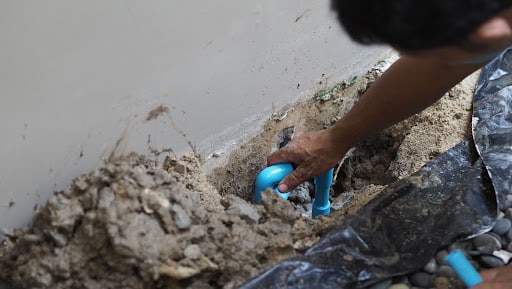You’ve probably seen it: a soggy patch in your yard, ballooning water bill, or drip‑like sounds when nothing’s running inside. That’s often the first clue that there’s an underground leak somewhere. But pipes under yards or concrete don’t give in easily.
Homeowners worry about damage, high bills, and even foundation issues. That’s where a plumber steps in, knowing how plumbers detect leaks underground with tools that don’t wreck your landscaping. It’s about zeroing in precisely to avoid massive digging.
Spotting the Signs Before Calling a Plumber
These are the usual clues that suggest locating water leaks underground is worth doing sooner rather than later:
- Water bills spike, with no increase in usage
- Soft or overly green patches in your lawn or driveway
- Sounds, like hissing or running, when faucets are off
- Low water pressure inside the house
- Soggy soil or pooling water in places with no visible source
Once these surface hints show up, a plumber knows it’s time to deploy their detection tools.
Step 1: Water Meter Test and Pressure Checks
Plumbers often begin by asking you to shut off all water inside your home and watch the water meter. If it keeps turning, there’s a leak. Then they may pressure test sections of pipe, filling them with air or water and looking for pressure drops. That helps narrow down which zone or section is leaking before they begin any digging.
Step 2: Listening for Leaks with Acoustic Devices
Because water under pressure makes noise, often faint hissing, plumbers use acoustic tools:
- Leak noise correlators: They attach sensors at two points on a pipe. By measuring how long it takes sound to travel, they can accurately pinpoint the break location.
- Ground microphones or listening sticks: These let the plumber literally listen to the leak through the soil above. Even a simple wooden cone and metal rod combo can pick up a whisper through the ground.
Acoustic methods are non‑invasive and often locate the leak exactly, so digging is precise.
Step 3: Moisture Testing with Soil Probes
Some plumbers use soil probes, thin metal rods inserted into the ground to test the moisture level. Higher than usual moisture in a spot may indicate water escaping underground near a pipe.
It’s simple, low‑cost, and works well in combination with listening tools.
Step 4: Tracer Gas or Dye Methods
For small or slow leaks, plumbers may inject non‑toxic tracer gas such as nitrogen into the water line. The gas escapes through the leak underground, rises to the surface, and a sensor above can detect it. That lets the plumber know exactly where to dig.
Dye can also be introduced into irrigation or invisible lines, though gas is more common underground.
Step 5: Thermal Imaging Cameras
Thermal imaging or infrared cameras can detect temperature differences in the ground surface caused by escaping water. Even if the leak is under concrete or soil, a thermal scan can reveal the slightly cooler (or warmer) patch above it.
This method is non‑invasive and especially useful where yard or slab replacement is costly.
Step 6: Pipe Locators and Electromagnetic Tools
Sometimes the issue is identifying exactly where underground water lines run before detecting the leak. Plumbers use pipe locators: a transmitter attaches to the pipe or tracer wire, and an electromagnetic receiver traces the underground route.
Locators help avoid mistakes; knowing where a pipe is and where it isn’t is key to accurate digging.
Step 7: CCTV or Sewer Camera Inspection
If a leak is suspected in a sewer or drainage line beneath concrete, plumbers may use a CCTV drain camera, a waterproof miniature camera fed through the pipe. It travels inside and shows exactly where cracks, root damage, or breaks are happening within.
That method goes beyond just detecting underground leaks; it shows internal pipe condition for planning repairs.
When That Fails: Advanced Tech and Monitoring Systems
For large networks, like municipal systems, or chronic leak issues, plumbers and utilities sometimes deploy fixed leak detection systems using acoustic monitors, fiber‑optic sensing, and real‑time analytics. These systems can monitor entire zones continuously and alert for tiny leaks before they surface.
Some solutions even use machine learning on amplified water‑flow sounds to catch leaks as small as 100 mL per minute.
Putting It All Together: How It Looks on a Job
Here’s how the process often plays out on a typical plumber visit:
- Initial homeowner chat: Ask about high bills, yard changes, and water pressure.
- Meter test: Shut off all water, watch meter.
- Visual inspection: Walk the yard, look for soggy or green spots.
- Soil probes: Test moisture in suspected areas.
- Acoustic scan: Correlator or listening probe to zone in.
- Thermal scan: Use a camera if the leak is slow or under the slab.
- Pipe trace: Locator to map pipe route.
- CCTV camera: If inside pipes are suspected.
- Plan exact dig: Mark a small area (often just a square foot or two).
- Repair and confirm: Fix the pipe, bury it, test again.
Why This Process Matters: Precision Saves Money and Yard
The focus on underground leak detection tools means minimal digging. You don’t see half your yard turned over. Repair time and costs stay low. And you avoid guessing where to dig, a “dry hole” can cost thousands in labor and landscaping.
An example: a homeowner who posted a review said they got a plumber at On Point Plumber out within a day, had clear answers at each step, and only had a tiny 2‑foot dig to fix a constant leak. That kind of real feedback shows the difference precise leak detection makes in service quality.
Tools & Technologies Summary Table
|
Method or Tool |
Purpose |
Benefit |
|
Water meter & pressure test |
Confirm if a leak exists |
Quick initial indicator |
|
Leak noise correlator |
Acoustic travel‑time detection |
Precise pinpointing |
|
Ground microphones or listening sticks |
Acoustic listening via soil |
Budget-friendly, effective |
|
Soil moisture probes |
Detect wet soil patches |
Spot test simple dry areas |
|
Tracer gas/dye |
Gas escapes through a leak |
High‑sensitivity detection |
|
Thermal imaging |
Surface temp changes |
Non‑invasive mapping |
|
Pipe locator (EM tracing) |
Map underground pipe paths |
Avoid digging wrong area |
|
CCTV drain camera |
Inspect the interior of the pipe |
Visual damage and leak confirmation |
|
Fixed monitoring system |
Continuous zone surveillance |
Early leak alerts, big networks |
How On Point Plumber Handles It
At On Point Plumber’s water leak repair page, they note they use acoustic correlators, thermal cameras, and tracers to avoid guesswork digging. Their team often locates leaks in under an hour after arrival, so repair is fast and focused. The benefit is clear: minimal disruption and upfront clarity on what’s needed.
Tips for Homeowners
- If you see signs, act early. Don’t wait for obvious flooding.
- Ask the plumber what techniques they’ll use, and prefer those offering non‑invasive tools first.
- Always confirm they’ll test again after the repair to ensure the leak is gone.
- Save the review details, like the one about quick arrival and clear answers, which helps others trust the process.
- Consider combining the detection and installation of a water alarm system to prevent future surprises.
Learn about water leak service repair at On Point Plumber if you get confirmation of an underground leak.
Reach out via our contact page for questions about timing, pricing, and same‑day service.
Frequently Asked Questions
How long does underground leak detection take?
Usually between 45 minutes to a few hours from arrival, visual scan, meter check, acoustic tools, and marking. Once marked, repair is quick.
Will they dig up my yard completely?
No. Modern leak detection lets plumbers dig only a small area, often just a few square feet, where the leak is pinpointed.
Does insurance cover underground water leak detection?
In many cases, yes, especially if mold or structural damage resulted. Check your policy. Detection costs are often covered unless deemed maintenance.
What if acoustic tools fail?
Then they may use tracer gas, thermal imaging, or even CCTV camera inspection inside pipes to find the precise location or inside damage.
How much does it cost to detect and repair an underground leak?
It varies. Detection alone is small, often bundled with repair. Total cost depends on pipe location, length to replace, and complexity, often far less than tearing up the yard without precision.

